

Stony Brook Center for News Literacy. The full News Literacy course, developed at Stony Brook University, organizes the material into 8 concepts that are spread amongst our 14 week course that take students from the first information revolution of Johannes Gutenberg's printing press to the Digital Age of Mark Zuckerberg's Facebook.

Each lesson stands alone or can easily be integrated into your program. Below, find a summary of each of those lessons, and a link to the most updated version of the teaching materials for each from our professors at Stony Brook University. Five Laws of MIL. Five Laws of Media and Information Literacy We are travelling towards the universality of books, the Internet and all forms of “containers of knowledge”.
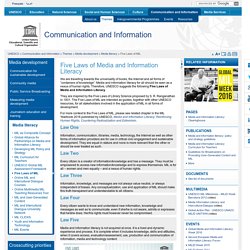
Media and information literacy for all should be seen as a nexus of human rights. Therefore, UNESCO suggests the following Five Laws of Media and Information Literacy. They are inspired by the Five Laws of Library Science proposed by S. R. Media and Information Literacy – MIL. Media and information literacy (MIL) is considered a crucial competence in today’s society.
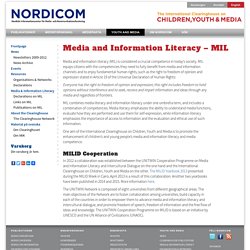
MIL equips citizens with the competencies they need to fully benefit from media and information channels and to enjoy fundamental human rights, such as the right to freedom of opinion and expression stated in Article 19 of the Universal Declaration of Human Rights: Everyone has the right to freedom of opinion and expression; this right includes freedom to hold opinions without interference and to seek, receive and impart information and ideas through any media and regardless of frontiers. Getting literal about media literacy in K12. The issue of fake news drew national attention during the 2016 presidential campaign, when fabricated stories were widely accepted as genuine.

According to recent research, the problem extends to K12 classrooms, where students have trouble judging the credibility of online information. A national assessment of 203 middle school students by Stanford History Education Group at Stanford University found that more than 80 percent believed ads labeled “sponsored content” are a credible source for unbiased news. Now provided across 12 states, Stanford’s “Civic Online Reasoning,” which includes assessments to judge the credibility of information, consists of 56 news-literacy tasks to identify misinformation and fake articles on the internet. The results reveal that K12 students must learn how to distinguish between what’s fictional and what is real. MIK för mig - digital utbildning. Lär om medier - Barn, unga och medier.
Media Literacy. Better Internet for Kids - MIL for me. Social Media for Teachers: Guides, Resources, and Ideas. Although students are evermore connected to the social web, many of these networks remain out-of-class digital playgrounds where students congregate.
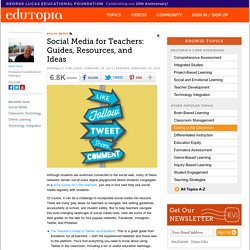
In a 2014 survey of 1,000 teachers, just one in five said they use social media regularly with students. Of course, it can be a challenge to incorporate social media into lessons. There are many gray areas for teachers to navigate, like setting guidelines, accessibility at school, and student safety. Expert på medier - digital kompetens i Lgr 11. Media Literacy: How to Close-Read Films and Videos. By Frank W.
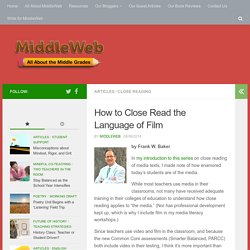
Baker In my introduction to this series on close reading of media texts, I made note of how enamored today’s students are of the media. While most teachers use media in their classrooms, not many have received adequate training in their colleges of education to understand how close reading applies to “the media.” (Nor has professional development kept up, which is why I include film in my media literacy workshops.) Since teachers use video and film in the classroom, and because the new Common Core assessments (Smarter Balanced, PARCC) both include video in their testing, I think it’s more important than ever that 21st century students become “critical viewers” and more “film literate.”
When students are challenged to “close read” a video/film, they must not only learn how to deconstruct the “media text,” they must also understand and appreciate all of the elements and techniques that are used to create it. “Films can be read like texts. The languages of the moving images 1. Blue Feed, Red Feed. What is this?
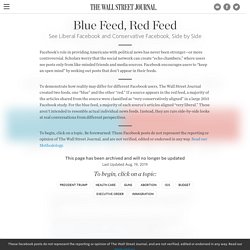
Recent posts from sources where the majority of shared articles aligned “very liberal” (blue, on the left) and “very conservative” (red, on the right) in a large Facebook study. In 2015, the journal Science published a research paper by Facebook scientists (Bakshy, Eytan; Messing, Solomon; Adamic, Lada, 2015, “Replication Data for: Exposure to Ideologically Diverse News and Opinion on Facebook”, Harvard Dataverse, V2) which looked at how a subset of the social network’s users reacted to the news appearing in their feeds.
For six months, Facebook tracked and analyzed the content shared by 10.1 million of its users (who were anonymized). These users had identified their political views in their own profiles on Facebook. Fake news: How not to fall for it. A 7-year-old recently found a picture of President Donald Trump on the internet and gazed at it indignantly.
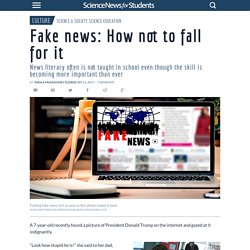
The Center for News Literacy helps kids learn how to check sources and find fake news. Center for News Literacy “Look how stupid he is!” She said to her dad, pointing to the image. The photo showed Trump writing his inaugural speech — with his pen turned upside down. Of course, the image was not the original photograph. His daughter “had a pre-existing belief that Trump was stupid. Quick Ideas for Visual and Media Literacy Lessons. As I was concluding my workshop presentation at a recent South Carolina School Librarians annual conference, a media specialist raised her hand to say that although she liked my ideas for media and visual literacy lessons, she would have difficulty finding time to do most of them.
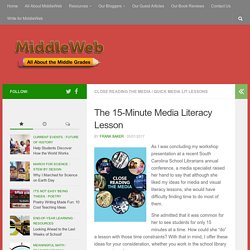
She admitted that it was common for her to see students for only 15 minutes at a time. How could she “do” a lesson with those time constraints? With that in mind, I offer these ideas for your consideration, whether you work in the school library space or in a classroom. Gather up a few magazines. Media Literacy: A Definition and More. Search form You are here Media Literacy: A Definition and More The definition most often cited in the US is a succinct sentence hammered out by participants at the 1992 Aspen Media Literacy Leadership Institute:

Introduction to Media Literacy. FREE Media Literacy Worksheets – Laura Randazzo – Solutions for the Secondary Classroom. Last week, Stanford researchers released a “bleak” report showing that more than 80 percent of students can’t determine the difference between real and fake news. (Alas, it seems this is something adults struggle with, as well.) The severity of students’ lack of media literacy was shocking to the study’s authors who were “taken aback by students’ lack of preparation…Many assume that because young people are fluent in social media they are equally savvy about what they find there. Our work shows the opposite.” What to do about this? I’m going to start by using Stanford’s own assessment tools with my students. Media & Information Literacy For Teachers – International, multimedia and multi-language media and information literacy teaching resources. Critical Media Literacy. 1. Constructions All media messages are constructions.How is the message constructed? How well does it represent reality?
2. Mod32 Core Concepts. Media literacy. ”Därför måste vi tala mer om hur medierna utvecklas” Förra året tillsatte regeringen en Framtidskommission med uppdraget att identifiera framtidens samhällsutmaningar. En av dessa utmaningar handlar om medielandskapets förändringar och dess betydelse för den politiska åsiktsbildningen, det politiska deltagandet, den sociala sammanhållningen och, ytterst, demokratin. Att medielandskapet har förändrats dramatiskt under de senaste decennierna är ingen nyhet. Public service-monopolet har brutits, antalet radio- och tv-kanaler har ökat dramatiskt, sändningstiderna i etermedierna har ökat kraftigt, och internet har tillkommit och blivit en integrerad del av våra liv.
I dag finns det en närmast obegränsad tillgång till nyheter och information från olika delar av världen. Aldrig har tillgången till information varit lika omfattande som nu. Den här utvecklingen är på många sätt oerhört positiv, men den innebär också stora utmaningar. Inte minst ur det senare perspektivet innebär medieutvecklingen en utmaning. Resultaten är tydliga. Vem behöver sanning när det finns känslor? Högern närmar sig althögern och ”alternativa fakta” har slagit igenom i Sverige enligt Trump-modell.Foto: Lars Pehrson/SvD/TT Aftonbladets ledarsida är oberoende socialdemokratisk. Ledarsidan driver opinion för jämlikhet, rättvisa, feminism och allas lika värde.
Anna Kinberg Batra anklagar Jonas Gardell för hat. Dagens Nyheters ledarsida jämställer Jonas Sjöstedt med Jimmie Åkesson. Den liberale debattören Fredrik Segerfeldt skriver att Donald Trump är socialdemokrat. After Comet Ping Pong and Pizzagate, teachers tackle fake news. History teacher Chris Dier was in the middle of a lesson last week at Chalmette High School in Chalmette, La., when a student made a befuddling inquiry: “He raised his hand and asked if I knew about Hillary Clinton using pizza places to traffic people.” About a thousand miles away at Wilson High School in Northwest Washington, distressed students in teacher Eden McCauslin’s history and government classes asked why a North Carolina man armed with an assault rifle had appeared at their local pizza shop, Comet Ping Pong, telling police that he wanted to free child sex slaves he believed to be harbored there, a false narrative conspiracy theorists have pushed on the Internet.
[Pizzagate: From rumor, to hashtag, to gunfire in D.C.] Hoaxes, fake news and conspiracy theories have abounded on the Web, spreading with increasing speed and intensity during the recent presidential election cycle. As the Comet Ping Pong incident displayed, such false accounts can inspire very real consequences. Media Literacy Clearinghouse.
Lessonbucket - VCE Media, VELS Media, Media Arts, digital literacy, media education, filmmaking.